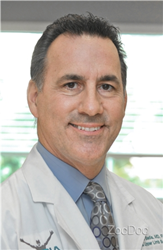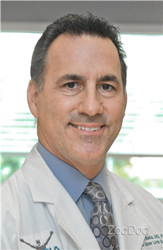
Dr. Alejandro Badia
Urgent care and ambulatory surgery centers devoted to one specialty are playing increasingly critical roles as providers of higher-quality and more affordable care in this era of health reform.
MIAMI (PRWEB)
December 19, 2019
When it comes to needing immediate treatment for non-life-threatening injuries or illnesses, who you going to call? Not your local hospital ERs or primary physicians. They’re no longer the “Ghost-Busters” of health care, says noted orthopedic surgeon and health business innovator Alejandro Badia MD, FACS.
“The explosion of medical knowledge has made it impossible for general and primary physicians to have even cursory knowledge of all specialties. That’s why urgent care and ambulatory surgery centers devoted to one specialty are playing increasingly critical roles as providers of higher-quality and more affordable care in this era of health reform,” says Dr. Badia, a specialist in treating musculoskeletal disorders of the hand, wrists and other upper limbs and founder of OrthoNOW®, a single-specialty, urgent-care franchise operation.
The latest studies back him up. In a recent report from Deloitte, one of the world’s largest accounting firms, authors write, “Markets with a higher concentration of urgent care centers have lower ER visit rates,” indicating that the Affordable Care Act’s goal of reducing “inappropriate utilization of ERs” is being met in those areas. One key reason: ER costs can be as much as 10 times those of urgent care centers, according to a 2017 article in the Washington Post.
Dr. Badia concurs with the Deloitte findings. In fact, cost and care quality were major drivers of his determination to work with a business and financial expert in developing the OrthoNOW® model. His first OrthoNOW® medical center opened in Doral, Fla. in 2010. Since then, the operation has been rapidly expanding, opening comparable facilities in other major markets
“Too often, patients with orthopedic injuries or other musculoskeletal problems are sent by their primary physician – or go on their own — to a hospital emergency room for expensive care and unnecessary diagnostic tests before being ultimately referred to me for help,” relates Dr. Badia.
In a November 2019 article published online in Op-Med, Dr. Badia presented a scenario that he says can apply “to nearly all fields of medicine.”
“It’s not uncommon for a patient to present to me with wrist pain,” he writes. “While my experience and clinical [knowledge] will often lead me to a diagnosis immediately by just listening to the patient’s complaints, the patient who comes from a primary doctor [or as a follow-up from a hospital ER] may see me with an MRI already performed, a battery of blood tests done and, perhaps, even a course of physical therapy already in progress. The problem is that this patient may simply be suffering from [a common variant of] tendinitis, which will respond to a single corticosteroid injection.”
In other words, “the subspecialist makes the diagnosis much faster, with superior resolution of the clinical problem, and at much less cost, utilizing less testing and imaging studies,” Dr. Badia says.
But quicker diagnoses, fewer tests and lower charges are not the only reasons to choose single-specialty urgent care and ambulatory surgery centers, Dr. Badia says. Patient safety is another important factor.
A study presented at the 2016 annual meeting of the Society of Military Orthopaedic Surgeons determined that a “significant number” of orthopedic conditions seen at some Level I trauma centers are “misdiagnosed and ineffectively managed.” Only “a mere 22 percent of [adult] orthopedic consults were accurate,” study authors said.
Meanwhile, in a study discussed at an American Academy of Pediatrics National Conference & Exhibition about five years ago, University of Maryland School of Medicine researchers reported that more than 90 percent of “potential pediatric fractures” are incorrectly splinted by health care professionals in hospital emergency rooms and by general physicians in non-orthopedic-specific urgent care settings. Improper splinting can lead to additional patient injury, including skin complications, excessive swelling and failure to adequately immobilize the fractured area, the scientists indicated.
An article Dr. Badia authored for Miami Medicine cites a seven-year study by KNG Health Consulting, which found that “moving a variety of surgical procedures into ambulatory surgical centers [and] away from hospital centers greatly decreases the cost of treatment” without overutilization or increased patient self-referrals.
As to the value of freestanding orthopedic clinics and other single-specialty centers to health reform, Dr. Badia says, “All one has to do is ask the patient who has been treated at one of these facilities. Patient satisfaction tends to be high.”
That satisfaction is reflected in the rapid rise of urgent care centers generally — and single-specialty centers specifically — throughout the United States. Statista.com reports, in 2018, urgent care centers in this country totaled 8,774, up from about 6,000 in 2013.
“We have seen the advent of orthopedic urgent care centers in select markets throughout the country,” Dr. Badia adds. “Now, we simply need to expand this concept to other specialties of medicine as a way of enhancing overall patient access to quality, low-cost health care.”
Alejandro Badia, MD, FACS, internationally renowned hand and upper-limb surgeon and founder of Badia Hand to Shoulder Center and OrthoNOW®, a walk-in orthopedic care clinic. He is a member of the American Society for Surgery of the Hand, American Association for Hand Surgery and the American Academy of Orthopedic Surgeons and an honorary member of many international professional hand societies. Dr. Badia specializes in treating all problems related to the hand and upper extremities, including trauma, sports injury, joint reconstruction, nerve injuries and arthroscopic surgeries. http://www.OrthoNOWcare.com and http://www.drbadia.com.
Share article on social media or email:

